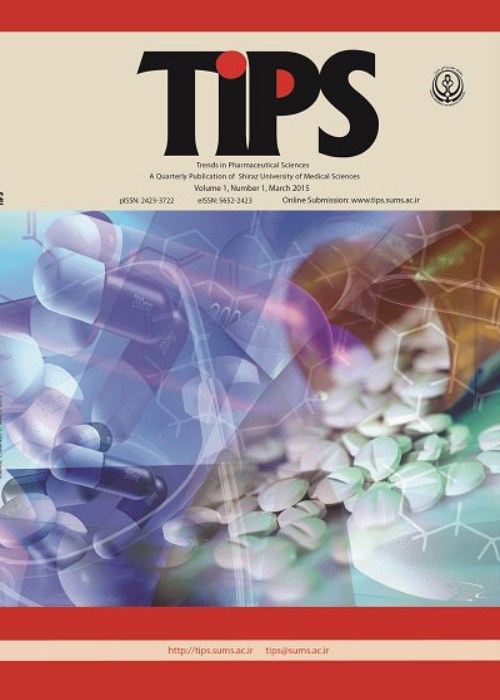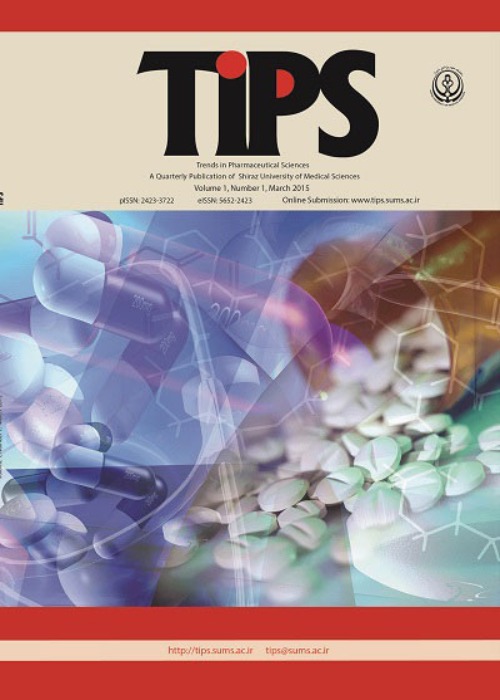فهرست مطالب

Trends in Pharmaceutical Sciences
Volume:9 Issue: 1, Mar 2023
- تاریخ انتشار: 1401/12/10
- تعداد عناوین: 8
-
Pages 1-14
Cholestasis/cirrhosis is a multifaceted clinical complication that influences many organs, including the liver, kidney, heart, skeletal muscle, and lung. Cirrhosis-associated lung injury could lead to severe and lethal consequences, including acute respiratory syndrome and patient dearth. Unfortunately, there is no specific pharmacological intervention to manage cholestasis-induced lung injury. It has been revealed that severe inflammation and its associated complications, such as oxidative stress, are involved in the pathogenesis of cholestasis-associated pulmonary damage. The current study was designed to evaluate the role of dexamethasone (DXM) on lung inflammation in cholestatic mice. For this purpose, bile duct ligated (BDL) mice received DXM (1 and 2.5 mg/kg, i.p, 2 times/week) for 14 days. On day 15, the bronchoalveolar lavage fluid (BALF) was prepared. Several markers, including inflammatory cell infiltration, TNF-α, and IgG, were assessed in the BALF of BDL animals. Significant infiltration of inflammatory cells along with increased TNF-α and IgG were detected in the BALF of BDL mice (14 days after surgery). Moreover, significant ROS formation, glutathione depletion, lipid peroxidation, and protein carbonylation were evident in the lung tissue of the BDL group. It was found that DXM (1 and 2.5 mg/kg) significantly blunted inflammation and oxidative stress in the lung of cholestatic mice. Moreover, lung tissue histopathological changes, including inflammatory cell infiltration, were significantly mitigated in DXM-treated mice. These data offer the potential therapeutic effects of DXM against cholestasis-related complications. Therefore, patients with cholestasis-induced lung injury might benefit from repurposing DXM in clinical settings.
Keywords: Bile acid, Inflammation, Lung injury, Oxidative stress, Pulmonary disease -
Pages 15-26Quantitative structure activity relationships (QSAR) studies, as one of the most important areas in chemometrics, play a fundamental role in predicting the biological activity of new compounds and identifying ligand-receptor interactions. Quantitative relationships between molecular structure and methionine aminopeptidase-2 inhibitory activity of a series of anthranilic acid sulfonamides derivatives were discovered by different chemometrics tools including factor analysis based multiple linear regressions (FA-MLR), principale component regression analysis (PCRA) and genetic algorithm-partial least squares GA-PLS. The FA-MLR describes the effect of geometrical and quantum indices on enzyme inhibition activity of the studied molecules. The quality of PCRA equation is better than those derived from FA-MLR. GA-PLS analysis indicated that the topological (IC4 and MPC06), constitutional (nf) and geometrical (G (N..S)) parameters were the most significant parameters on methionine aminopeptidase-2 inhibitory activity. A comparison between the different statistical methods employed revealed that GA-PLS represented superior results and it could explain and predict 85% and 77% of variances in the pIC50 data, respectively.Keywords: anthranilic acid sulfonamides, MetAP-2 inhibitors, QSAR, GA-PLS, PCRA, FA-MLR
-
Pages 27-34Bridelia ferruginea Benth. (Euphorbiaceae) is a plant used for various medicinal purposes including the treatment of protozoan infections in many African countries. The present study was aimed to evaluate the in vitro antimalarial, antimicrobial and antitrypanasomal activity of the methanol crude extract and fractions of the medicinal plant, Bridelia ferruginea. Crude extract from dried leaves of Bridelia ferruginea was prepared by cold maceration and fractionated using a reverse phase column under reduced pressure with water – methanol mixtures. The extracts and fractions were tested to determine their biological activities. In vitro antimalarial activity was determined by the plasmodial lactate dehydrogenase culture sensitivity assay while antitrypanosomal activity was tested in vitro against a culture of Trypanosoma brucei promastigotes. The crude extract of B. ferruginea exhibited significant antitrypanasomal activity with an IC50 of 8.48 µg/mL which was further enhanced in some of the fractions like the MeOH fraction (BFD) with an IC50 of 1.04 µg/Ml which indicates very good activity. Sub – fraction BFF (obtained from 1:3 H2O:MeOH fraction – BFC) exhibited the best antimalarial activity among all the fractions and sub – fractions with an IC50 value of 19.73 µg/mL against P. falciparum D6 and 20.49 µg/mL against P. falciparum W2. There was no observable antibacterial or antifungal activity for all crude extracts, fractions and sub – fractions. The results from this study have validated the leaves of Bridelia ferruginea as potential sources of antimalarial and antitrypanosomal agents which can serve as a lead in drug development.Keywords: Antimalarial, Antimicrobial, Antitrypanosomal. Bridelia ferruginea, in vitro
-
Pages 35-44Genetic engineering of maize plants for improved yield, drought and pest resistance has received considerable attention in agricultural research. This work aims to develop metronidazole microspheres using starches obtained from genetically modified maize cultivars as controlled release polymers. Metronidazole microspheres were prepared by ionotropic gelation method using polymer blend of starches (A and B) isolated from genetically modified maize grains and sodium alginate. The microspheres were characterized using scanning electron microscopy (SEM) and Fourier transform infrared spectroscopy (FTIR). A 32 factorial design was employed using the entrapment efficiency, time taken for 50% (T50) and 90 % (T90) drug release as dependent variables while A, B and polymer-drug ratio were independent variables. SEM reveals that the formulations are polyhedral, hard and discrete with a smooth surface. Metronidazole microspheres formulations containing starch isolates from maize genotypes had significantly higher (p<0.05) entrapment efficiency. Formulations containing a blend of starch and alginate showed a more sustained release than the formulations having only alginate. Values of T90 ranged between 6.12±3.20 to 47.13±7.01 hrs suggesting a sustained release of the drug. Generally, drug release from the microspheres was through erosion and polymer relaxation The effect of type of polymer on the dissolution times was more significant (p<0.05) than those of polymer: drug ratio. This result shows that starches obtained from genetically modified maize grains can be employed as sustained release polymers in the formulation of metronidazole microspheres.Keywords: Maize starch, genetic modification, metronidazole microspheres, release properties
-
Pages 45-54Objective(s)
The harmful effects of antibiotic misuse have been demonstrated as a cause of the spread of antibiotic-resistant pathogens. Due to the increasing resistance of bacteria to antibiotics, there is a need to use new substances to control bacteria. Recently, there has been an interest in identifying plants with pharmacological and antibiotic effects.
Materials and methodsThis study was performed to evaluate the antibacterial effects of Iranian rhubarb (Rheum ribes) in vitro on Listeria monocytogenes and Yersinia enterocolitica. For this purpose, ethanolic and methanolic extracts of roots, stems, leaves, and flowers of rhubarb were prepared, and the antibacterial effects of the extracts were evaluated by the broth microdilution method.
ResultsThe results showed the antimicrobial effect of methanolic extracts of different parts of the rhubarb plant is more than its ethanolic extracts and the effect of rhubarb extract on L. monocytogenes is more than its effect on Y. enterocolitica. The most antimicrobial effect on L. monocytogenes belongs to the methanolic extracts of leaves and stems, and the ethanolic extracts of leaves, and stems. Concerning Y. enterocolitica, the most antimicrobial properties belong to the methanolic extracts of leaves and ethanolic extracts of stems.
ConclusionsAmong the ethanolic and methanolic extracts of different parts of rhubarb, the most antimicrobial effect belongs to the methanolic extract of the leaf and the ethanolic extract of the stem. Herbal extracts can be investigated for their beneficial effects in the control of foodborne infectious diseases.
Keywords: Rheum ribes, Antibacterial activity, Medicinal plant, Antibacterial agents -
Pages 55-70
Cholestasis is not only influences the hepatic function but also damages many other organs. Lung injury is a critical secondary organ damage associated with cholestasis/cirrhosis. Pulmonary histopathological alterations, respiratory distress, and hypoxia are related to cholestasis/cirrhosis-induced lung injury. It has been found that oxidative stress plays a crucial role in this complication. The current study was designed to investigate the effect of N-acetyl cysteine (NAC) and dithiothreitol (DTT) as thiol-reducing and antioxidant agents against cholestasis-induced lung injury. Bile duct ligated (BDL) rats were monitored for the presence of inflammatory cells, TNF-α, and IgG levels in their broncho-alveolar fluid (BALF) at scheduled time intervals (3, 7, 14, and 28 days post-BDL surgery). These markers reached their highest level in the BALF of BDL rats on day 28 after the surgery. Therefore, in another set of experiments, the BDL animals were treated with NAC (100 and 300 mg/kg/day, i.p, for 28 consecutive days) and DTT (10 and 20 mg/kg/day, i.p, for 28 consecutive days). Meanwhile, a significant increase in the levels of TNF-α and IgG was detected in the BALF of BDL rats. The BALF level of neutrophils, monocytes, and lymphocytes was also significantly increased in cholestatic animals. A significant increase in lung tissue biomarkers of oxidative stress was detected in the BDL rats. It was found that NAC and DTT could significantly blunt pulmonary damage induced by cholestasis. The effects of these agents on oxidative stress biomarkers and inflammatory response seem to play a pivotal role in their mechanisms of protective properties.
Keywords: Bile acid, Cirrhosis, Cholestasis, Inflammation, Oxidative stress, Pulmonary injury -
Pages 71-86
Today rapid and reliable analytical method for determining the trace level of targeted analytes in biological analysis and different fields is an essential object in analysis. So we try to focus on novel methods suggested for improving solid-phase microextraction based on novel drug delivery systems, especially nanoparticles. Nanoparticles like (dendrimer, carbon-based nanoparticles, magnetic and mesoporous nanoparticles, …) and their application as a new sorbent combined with different methods such as solid microextraction and liquid microextraction techniques are discussed in this article. These nano sorbents induced the potentials like selectivity and sensitivity for these methods. Furthermore, this nano extraction caused the lower consumption of hazardous solvent and reduced the total time needed for the extraction procedure, especially in biological analysis. The beneficial effects of nanoparticles indicated that a meaningful future was expected for their application. These new sorbents can be evolved the analytical methods and create reliable and rapid analytical methods.
Keywords: Microextraction, Nanoparticle, nanosorbent, nanoextraction, biological analysis -
Pages 87-92
Despite the need to use prophylactic antimicrobials to prevent infection at the surgical site, in many cases the use of prophylactic antibiotics is inappropriate. The aim of this study was to determine the pattern use of surgical site infection antibiotics prophylaxis based on standard guidelines in a teaching hospital in Shiraz. In this observational study, information of 338 patients from May to October 2020 received prophylactic antibiotics before surgery at Shahid Faghihi Hospital affiliated to Shiraz University of Medical Sciences was reviewed. Type of antibiotics, combination of antibiotics, dose and duration of treatment for each patient were defined based on both the American Society of Health-System Pharmacists (ASHP) and the National Ministry of Health and Medical Education of Iran guidelines for antimicrobial prophylaxis in surgery. Of the total 338 patients included in this study, only 27.5% received antibiotic prophylaxis according to standard guidelines. The most commonly used antibiotic class for surgical site infection prophylaxis was the first generation cephalosporins. The highest rate of antibiotic prophylaxis appropriateness was identified in the urology ward (11.53%). Few cases of antibiotic prophylaxis have shown complete compliance with the standard guidelines in this preliminary report.
Keywords: Antibiotic Prophylaxis, Surgery, hospital


